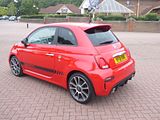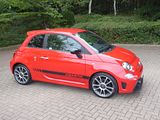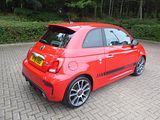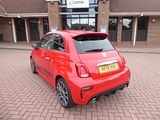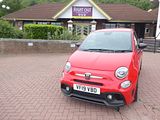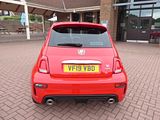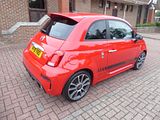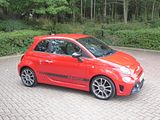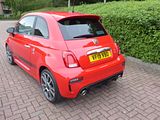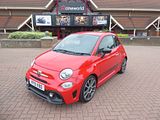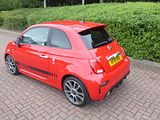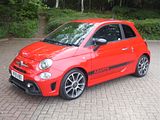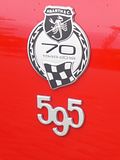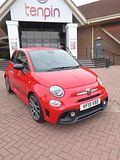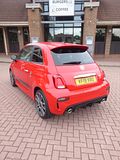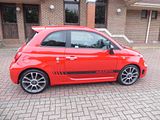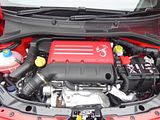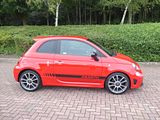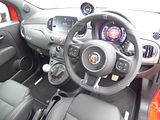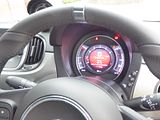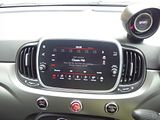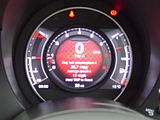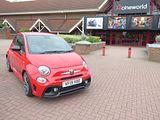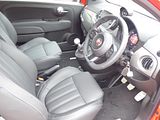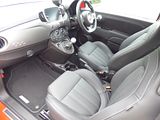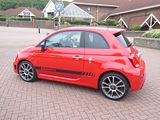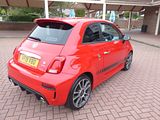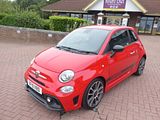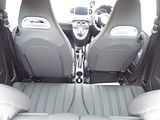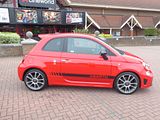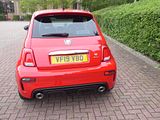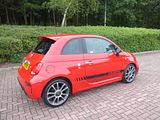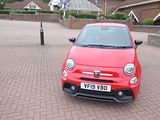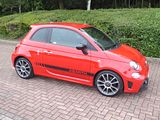Back in April 2010 I rented an early Abarth 500 from Hertz UK for a long weekend. I loved it so much, that later on the same day as I had returned it to Hertz, I was at a dealer discussing the purchase of my own car. I did not need it, as I had a perfectly good company car, but I wanted it. When I got it, a few weeks later, I said that I would keep it “for ever”. This was my solution to the classic car challenge, where the car has to live outside, and I soon found that even though this was a brand new car, it had rights of entry to just about any car show as a modern classic or even a junior supercar. It was not long before Abarth introduced upgraded models, with the 595 Turismo and Competizione cars being launched in the spring of 2012. 160 bhp engines from the factory and extra features were appealing, but even though I admired those that were bought by people I got to know as part of a growing Owners’ Community that I joined and then started to run, I remained resolute that I had my car, and with an average of only 4000 miles being covered, was sure it really would last if not “for ever” then certainly a long time. More changes ensued and when the Competizione was upgraded to 180 bhp and my cars was over 5 years old, the inevitable happened and I swapped out the 2010 car for one of the latest models. If the 595 cars were known as the Series 2, then a few more changes including a TFT instrument dial had created the Series 3 and my Cordolo Red duly arrived in September 2015 and was immediately an evident improvement over the first car in many ways: more power, better ride, better sound, stronger brakes, fabulous Sabelt seats and a feeling of slightly tighter build quality that you get when cars have been in production a while. Only a few months later, though a Series 4 car arrived. This had new lights front and back, reprofiled bumpers, a range of different colours and wheel trims and a few other equipment changes. Sales increased markedly as this was the era when PCP deals really took off, so every Abarth event started to feature more and more of these cars. Nice though they were, and the new colours really were appealing, I was not tempted, and so, three years after the arrival of the first of the Series 4 cars in the UK, I’d still not even driven one, the dealer always giving me something other than an Abarth as a loan car when my car was in for service. Finally, in August 2019, when I handed my car in for its annual service, the dealer declared that he had an Abarth for me. I could hardly say “no”.
The car in question was obviously going to be a Series 4 car, and given the rather dreary weather of this August day, the photographer was pleased to find that it was painted in the only red colour currently offered, which is called Abarth Red, a brighter shade than either of the two different red Abarths I have owned. As this loan car had been registered earlier in the year it turned out to be one of the 70th Anniversary Edition badged cars. 2019 marks the 70th anniversary of the creation of the original Abarth company and accordingly, one way that modern Abarth is marking this is by adding special badges to the flanks of the car.
When I upgraded my car from the 135 bhp entry level model to the 180 bhp Competizione, the difference in the driving experience and indeed the raw power was immediately noticeable. The Turismo sits between the two with a quoted 165 bhp, so I did wonder if I would now feel short changed having got used to more power than that. As I set off down the road, I really did feel quite disappointed that this car felt nothing like as good as mine. And then I remembered that the latest cars need you to engage Sport mode every time you switch the ignition on, whereas mine stays permanently in that setting. Pushing that one button transformed the car, It really came to life, with a much greater sense of urgency about the acceleration, a sharper throttle response, more weight in the steering and better noise. People often ask among the owner communities if they should keep Sport on all the time, and the answer generally is “yes”, and here was the proof. Even without being able to undertake a scientifically measured test, I could discern that this car was not quite as fast as mine, but it did not feel far off, and I think most people who drive it will still be amazed at how rapid it is. The car accelerates strongly from any point in the rev range, with only mild hesitation from the turbo and there is particularly good mid range pull once the turbo is in its optimum boost zone. The engine is quite happy to be revved hard and indeed that is how these cars are designed to be driven. It does get noisier as you near the red line, but Abarth drivers don’t really care about that fact. This car had the standard exhaust system on it, and although the principle is not unlike that of the Monza system on my car, it is not as loud or burbly. Those outside the car probably get more benefit from it than those inside. The gearlever is mounted in the dash, and falls to hand perfectly. There are only five gears, but this is not really an issue, as the gears are well spaced, and whilst acceleration is not strong in fifth, there is some available without the need to change down, but as the lever slots so cleanly between gears using them all is no hardship. The Sport button makes a huge difference to the steering. Switched off, it is quite light but devoid of feel, whereas switched on whilst it does weight things up quite noticeably you get a much better sensation as to what the steered wheels are going to do. And that matters if you are going to drive this car in the way it begs to be driven. This is a fun machine on the twisty roads, feeling more like a large go-cart than anything else, and it really does just go where you point it. It is nimble and agile, there is no body roll and it feels more like it is on rails than wheels, with huge levels of grip. It’s not all good news: the quick steering rack means that the turning circle will surprise you, with the car needing more back and forth than you will expect, and the ride is on the firm side. This one came on 17″ wheels. Maybe I have just got used to it, but I find it comfortable enough, whereas others, I know are less convinced citing firmness and an element of bounce on some surfaces. The brakes are good and it is excellent to see that there is still a pull-up handbrake lever between the seats. That poor steering lock notwithstanding, this is an easy car to position on the road and to park up. Let’s face it, it is one of the smallest new cars available and the stubby front and hatch rear end mean that judging the extremities is easy. There are rear parking sensors to help you, too.
There were a few changes made to the interior of the Series 4 cars, but mostly this is all very familiar, even down to the dash still having a 500 logo in front of the passenger. If you are looking for high quality soft touch plastics, then this is not the car for you, but what you get is perfectly acceptable, functional and durable, with a touch of sporting style coming from the chunky leather wrapped wheel with a flattened bottom and the boos gauge mounted in a pod to the side of the instrument display. There is a single instrument dial, very much in the style of the Nuova 500 of the late 50s, but in this car the designers have cleverly incorporated what others would deliver with four separate dials in the one entity. It uses TFT technology, so looks good and is easy to read with very sharp graphics. The largest entity is he rev counter and there are gauges to the side for water temperature and fuel levels, with a digital speedo right in the centre. Warning lights go where there is space and there are trip computer functions below the speedo. which y cycle through by pressing the buttons outside the dial unit. There are twin column stalks, with lights operated by twisting the end of the indicator stalk. One difference my car is that you now get auto lights and auto wipers. The centre of the dash is where the biggest change has taken place as out went the Blue & Me system and in came uConnect, with a proper display screen of either 5 or 7″, the latter including an optional navigation system. This was not fitted to the test car. Beneath this are air vents and then the buttons for the automated climate control, unchanged from the earlier cars. Switches for the electric windows are on the dash. to either side of the gearlever. As with my car, there is a metal gear knob, which looks good but can be a mixed blessing in extreme heat or cold.
The Turismo has the standard high-backed seats, as opposed to the Sabelts. Some people prefer them, and there are two main reasons why this might be the case. The Sabelts are quite figure hugging and some find that uncomfortable, or simply do not fit, and the other issue is that they have no height adjustment, so if you want to sit lower the only solution is to get an after-market lowering bracket. With the standard seat there is a height adjuster for the driver. It does not allow you to set the seat that low, so you will still feel you are sitting on the car rather than in it, but once you get used to this, most people are fine with it and there is still ample headroom. Personally, I prefer the Sabelts, which I find more comfortable, but the advice is always to try both. You can adjust the fore/aft and the backrest angle and there steering column goes up/down (but not in/out), so there is plenty of adjustment potential to get the right driving position.
Everyone assumes that as this is a small car, then the back seats will be useless for anyone bigger than a small child, and that is not actually the case. For sure, getting in does require a certain level of agility, as whilst the front doors are quite long, the front seat merely slides forward a little and the backrest tips forward a little, so there is not that large a space through which you need to clamber, to get in. Nut once installed, there is more room that you might have been expecting, though definitely only for two people. The Abarth really is not wide enough for three. The amount of legroom will depend, of course, on how far back the front seats are set, but unless they are at the rear of their travel, there is room for adult legs here, and the headroom is such that only the really tall are likely to struggle. Certainly people of my size can fit with ease, and I know of many owners where a family of four have gone on long journeys in this car. There’s not much for rear seat occupants to play with though – no USB ports, no air vents, just a side window to look out of. The boot is commensurate with the compact dimensions of the car. It’s big enough for shopping, though it relies more on depth than length for its capacity and the sloping rear of the design means that the height reduces, but the base floor area is reasonable and I have managed to get three soft bags in the boot of my car with no difficulty. There is no spare wheel, but under the main floor there is a well which houses the tyre repair kit and has a bit of space for you to tuck odds and ends around it. The seat backs are split 50/50 and drop down to give a longer load platform, and in this mode you can get quite a lot of stuff in the car. Certainly, I’ve seen people with four tyres or a bulky bike accommodate without a problem. The latest cars now have a proper glovebox, as was always the case with US market cars, where before there was just a shelf and a well hidden tiny compartment and there are generously sized pockets on the doors, as well as a pair of cupholders in the centre console.
The initial Abarth 500 range of 2008 was very simple, but the evolution of the car and a vast array of limited edition models has made this something of a minefield, even before you realise that a lot of owners modify their cars, many of them adding features from the higher end models to those that lack them. For the last few years there have been three core models: the entry level car is now known as the 500 Custom and the latest versions have what is quoted to be a 145 bhp engine. Not quite as cheap as it once was, this is still something of a bargain and it comes with plenty of goodies, including 16″ alloys, air conditioning and a 5″ uConnect screen. Costing an extra £3200, the 595 Turismo is the mid-spec car with upgraded trim and equipment and a 165 bhp engine. Also standard are 17″ alloy wheels, leather seats and the 7″ uConnect display screen. The Competizione, costing an extra £2100, sat at the top of the range with 180 bhp and most of the available features fitted as standard, including the Monza exhaust, Koni dampers, 4 pot Brembo discs, Sabelt seats and niceties such as a metal fuel filler and oil filler cap and an auto dipping mirror. A new 595 Esseesse joined the range a few weeks ago. This costs £25,295 price tag, but it is also better equipped. The engine is, perhaps surprisingly, the same as the Competizione, but it breathes through a new air filter and an Akrapovic exhaust system, while upgraded rear suspension and a limited-slip differential have been fitted to help the car corner and accelerate better. There are styling upgrades, too, with white alloy wheels, Abarth side stripes and white door mirrors. Inside, there are sports seats with a carbon shell and carbon pedals in the footwell, while the touchscreen infotainment system includes car telemetry readouts for track driving. There are C models available in all trims, which bring open-air motoring (and a reduced boot) to the table. Most of the limited edition cars, of which there have been plenty in recent times, with names such as Trofeo and Pista have been based on the Turismo. There are plenty of options allowing you to personalise you car, and certainly we reckon that even when several tens of Abarths assemble together there are never two that are identical. There are several colours including a number of bi-colore two tone combinations, and stickers for the bonnet, roof and sides, as well as a number of different wheel designs. A small number of cars have the glass Skydome sunroof.
It goes without saying that I enjoyed the chance to drive this car, as my enthusiasm for the Abarth is at least as strong now as it was back in 2010 when I first drove and subsequently bought one. This test did confirm a couple of things to me, though: when the Series 4 car came out, I was not tempted to swap my early 180 bhp Competizione for one, as most of the differences were cosmetic, with the possibility of a factory integrated navigation unit being the only thing I would really like; also, this test confirmed for me that the premium for the 180 bhp car was worth it over the Turismo. The extra power, the Sabelt seats and the Monza exhaust all delight me every time I drive my car and the ride on the Koni dampers is better than the first car was and a little bit better than this one. So, whilst the Turismo is a fun machine, which will put a huge smile on the face of anyone who drives one or who buys one, if you can stretch to a Competizione, I think you will feel the extra money was well spent.


